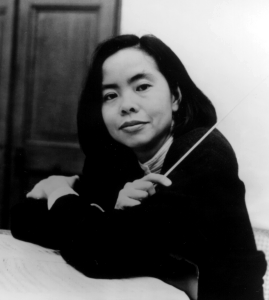Reviews
about Piccolo Concertino:
“several of tonight’s arrangements are written to spotlight specific instruments. On the high end we have Bun Ching Lam’s “Piccolo Concertino.” Or as she puts it, her first stab at writing an abstract piece for a small instrument. Superbly played, it ranges from sustained “somebody-please-get-that-tea-kettle” squeaks to the flit and flutter of its beautifully lilting trills.
–Rolling Stone
Two pieces stood out as music one might want to return to in detail, each for soloist with ensemble. Bun-Ching Lam’s Piccolo Concertino succeeded in making music that was thoughtful and probing for an instrument often used only for brilliance. Constructed primarily from overlapping long lines, streams of notes passed from instrument to instrument, Lam made canny use of the lower register of the instrument and of unusual pairings – the “orchestra” was composed of oboe, clarinet, French horn, trumpet, violin, viola, cello, bass and percussion. Lina Andonovska played the piccolo part with a varied palette and with intensely focused calm.
–The Boston Musical Intelligencer
Lina Andonovska, an Australian, who distinguished herself throughout the evening doubling on flute and piccolo, explored manifold possibilities of the piccolo, from top to bottom, and drew smart lyrical conversation from the fine oboist from Nashville, Daniel Cutchen, in Bun-Ching Lam’s appealing “Piccolo Concertino”.
–The Berkshire Eagle
about Six Phenomena:
“The real gem of the evening, in fact, may have been Bun-Ching Lam’s Six Phenomena, a wonderfully engaging work built on the Buddhist Diamond Sutra, played with astounding sensitivity and insight by pianist Margaret Kampmeier.
–Washington Post
about Atlas:
“… the almost Weberian mosaic of Bun-Ching Lam. This Chinese lady is also experienced in creating blends, with music of beautifully clear instrumentation that smells of light spring blossoms.”
–Ernst Vermeulen, NRC Handelsblad
“In her work ‘Atlas,’ Chinese-American composer Bun-Ching Lam on the other hand uses a idiom of a predominantly Western tint. Debussy and Ravel ring through in the enchanting webs that open and close the piece, and in which the instruments pass the tones along to each other, as it were. In the middle part the sounds have been charmingly draped around ascending scales.”
–Frits van de Waa, Volkskrant
about Sudden Thunder:
“…lingers longest in the mind. It is an altogether mesmerizing sequence of meticulously detailed sonorities, swiftly moving from passages of static meditation to lashings of full orchestral forces. Lam drew on a postwar avant-garde vocabulary without lapsing into its cliches; she showed a clear sense of narrative purpose.”
–Alex Ross, New York Times
about Last Spring:
“… impressed as a considerable addition to the repertory….From its dramatic opening. A violent series of chord clusters on the keyboard playing off sustained unison harmonics in the strings, to the bold final pages, the two instrumental worlds remained distinct from one another.”
–John von Rhein, Chicago Tribune
about …Like Water:
“The music is put together immaculately, and much of it is hauntingly attractive.”
–Joshua Kossman, San Francisco Chronicle
about After Spring:
“The work of a real composer, who chose every note, every structure carefully, with commitment and feeling. This 15-minute work…evolves from an austere set of variations on a melodic cell into a glittering Romantic showpiece that…always maintained a personal voice.”
–Tim Page, New York Newsday
about The Child God:
“…in the concert of pieces by Bun-Ching Lam given as part of the Lincoln Center Out of Doors festival, held right up against the north wall of the Metropolitan opera as if this was a declaration of intent to move in.”
–Paul Griffiths, New York Times
“An operatic gem…Bun-Ching Lam’s music stretched the conventions of Chinese opera into intense evocations of grief, passion, and ultimate triumphIf the Child God ever comes your way, embrace it.”
–Leighton Kerner, The Village Voice
about Omi Hakkei:
“The first half of the program concludes with a startlingly evocative series of tone poems after the Japanese woodblock artist Hiroshige, ‘Omi Hakkei.’ Composer Bun-Ching Lam ingeniously uses three cross-cultural pairs of instrumentsviola-erhu, flute-dizi and harp-zither. This gorgeous work begs to be recorded.”
–Kansas City Star
about Song of the Pipa:
“Lam’s orchestration is colorful and creative….Her greatest accomplishment was in making an orchestra sound the way a Chinese brush painting looks: ordered and symbolic, yet ephemeral and without every detail spelled out.”
–The Star-Ledger
about Saudades de Macau:
“…a lovely, nostalgic five-movement travelogue of the composer’s native Macau. With a few simple, well-chosen strokesa slow rising melody in the prologue, or the calmly repeated chimes of a gong in the third movementLam conveys the essence of a musical scene, and the sureness with which each vignette gains in intensity is impressive”
–San Francisco Chronicle
about Circle:
“The piece is hauntingly beautiful with oriental colorings, yet entirely Americansomewhere between Bernstein and John Adams in style. The subtle sounds are regularly interrupted by brash and powerful accents that become the mood and then are gone. She [Bun-Ching Lam] has a keen sense of percussion and uses both rhythm and sound to articulate different cultures as if on a musical world tour.”
–The Source, Albany, New York
“Bun-Ching Lam presents music that is both Eastern and Western and neither, a new kind of fusion taking place to produce something fresh and quite original.”
–Eclectica Magazine v2n6

